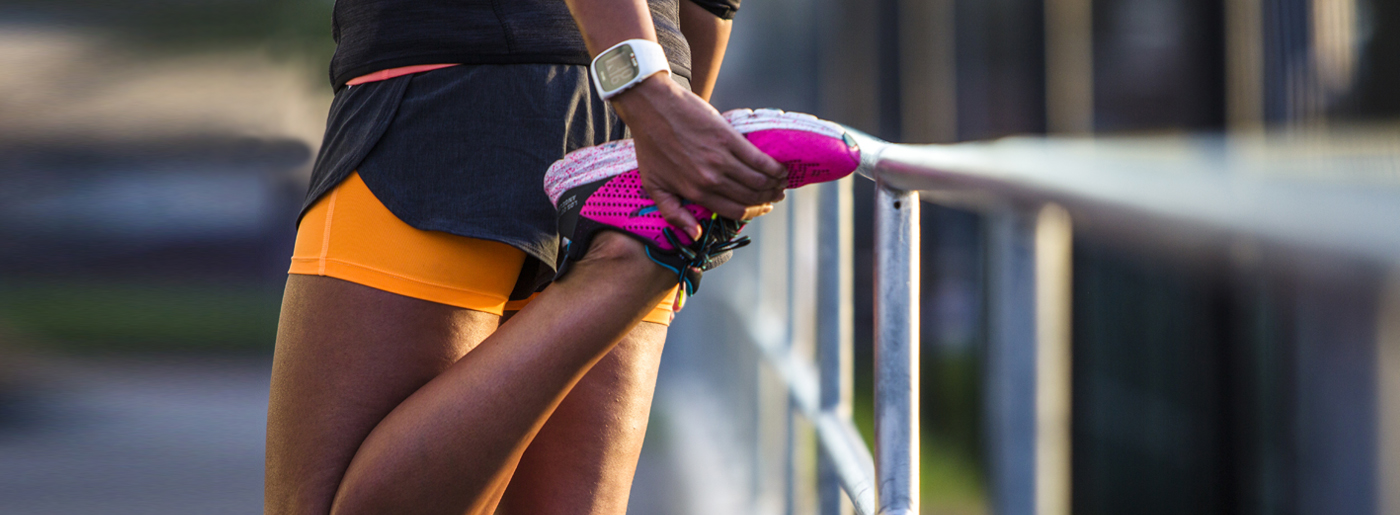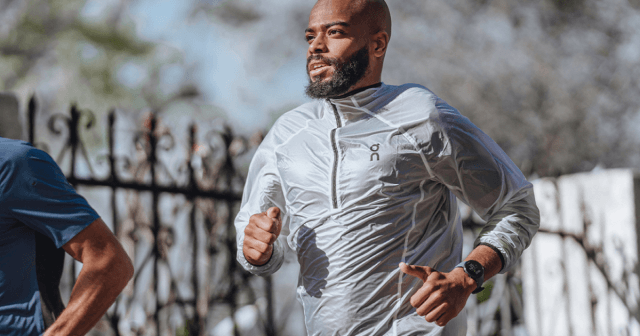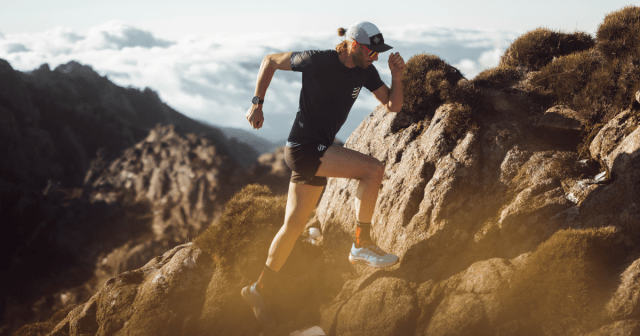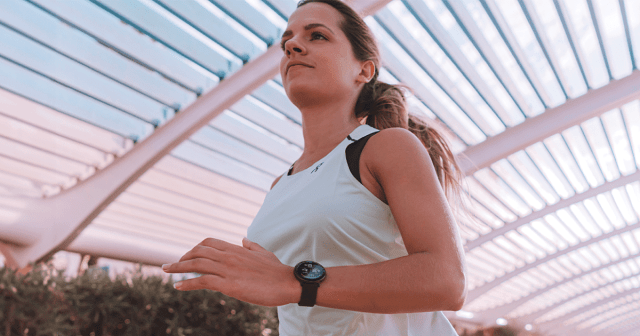Some running injuries pop up when we least expect them. Others are the result of overuse, a bit of abuse or because you’re an overly enthusiastic new runner. Some are preventable, some can be worked through on the run, and others will require total rest (and a whole lot of ice).
No matter how or why running injuries happen, it’s the worst. As a runner, one of the most brutal feelings in the world isn’t necessarily the physical pain of an injury. It’s sitting on a couch on a Saturday morning, sidelined, while the rest of the world (or at least your running buddies) wakes up to enjoy a nice, long run.
Here’s what New York City-based physical therapist Abby Bales, PT, DPT, CSCS, says all athletes should know about some of the most common running injuries.
Common Running Injury 1: Patellofemoral Pain Syndrome (Runner’s Knee)
What?
Knee pain that can result from improper tracking of the patella on the femur
Where?
The anterior-inferior/lateral knee
Why?
Muscular imbalances during a repetitive activity – like running – can cause asymmetric pulling of the patella to the superior/lateral direction, causing it to track over the femur improperly. That causes friction, which leads to inflammation, which leads to pain.
How to recover?
I prefer to assess the muscular imbalances from an activation standpoint so I can find out which muscles aren’t pulling their weight or if it’s a biomechanical problem in the gait cycle.
Typically, the quadriceps are overused and the adductors and gluteus medius and minimus are not properly being accessed during weight bearing and offloading. A well-rounded leg-strengthening routine – one that hits all three planes of motion, plus single-leg exercises – will help you maintain overall strength in order to offset the overuse during the repetitiveness of running.
How to prevent the injury?
Don’t skip leg day! During the off-season, build strength by adding load and velocity work three to four times per week. Maintain that strength during a training cycle by committing to leg-strengthening exercises two times per week. Foam rolling is also an excellent way to soften tissue – especially the quadriceps – and reduce tension.
Common Running Injury 2: Femoral Acetabular Impingement
What?
In the hip joint, where the femur articulates with the hip – that’s called the femoral acetabulum. There’s cartilage in the joint for smooth motion, a suction effect, and some load transfer. If one or both of the surfaces of the bones is misshapen or doesn’t match up to the other side, the joint won’t move smoothly and can grind away at the cartilage. This can also happen artificially if muscles that move the hip are tight, causing an asymmetrical grinding of the joint. (Translation: ouch.)
Where?
It’s typically a deep rear glute pain that can radiate throughout the hip. It may feel painful to sit, climb stairs, or cross your legs, and may hurt when squatting or lunging.
Why?
It can be a congenital malformation, or a result of muscular imbalances that no longer support the joint.
How to recover?
Conservative care is to help rehab the movements and weaknesses that aren’t allowing the joint to glide properly. This can include manual distraction, soft-tissue work, strengthening, and rest. The grinding can cause inflammation, and if there’s a tear, you’ll need to do some work before getting into training again.
How to prevent the injury?
If there’s a congenital malformation, there’s nothing to do to prevent it – it’s something you’re born with. Supporting the joint with a comprehensive strength training and stretching routine is the best way to prevent overuse.
Common Running Injury 3: Plantar Fasciitis
What?
Inflammation of the connective tissue on the plantar (underside) surface of the foot.
Where?
The heel when you stand up after sitting. It usually gets better after taking a few steps.
Why?
Overuse
How to recover?
Inflammation requires rest. Swimming or cycling as an alternative to running can help you keep training while you also seek a PT to determine the root cause. Strengthening the hips, core, and lower leg musculature and monitoring the biomechanics for abnormalities are the keys to rehabbing plantar fasciitis.
How to prevent the injury?
It’s often improper load transfer and lack of strength in the hips and glutes that cause the smaller muscles and soft tissue in the foot and lower leg to work too hard. When the lower leg is supported by strengthening the larger muscles up the kinetic chain, a runner is less likely to develop plantar fasciitis.
Common Running Injury 4: Gluteus Medius Tendinosis
What?
Inflammation of the proximal and/or distal attachment of the gluteus medius muscle
Where?
Usually the lateral side of the hip when you’re standing or stepping on the affected leg. It can also feel tender along the sacrum. As you jump from one leg to the other, one hip may drop and not remain level.
Why?
Lack of strength in the glues and core or altered body mechanics during the gait cycle, which cause the hip abductors to work too hard and the tendons to become inflamed.
How to recover?
Good old hip, glute, and core strengthening, especially in single-leg stance, and working on your running form.
How to prevent the injury?
Hip and glute strengthening is the key. So many runners only work in the sagittal plane, doing things like squats and lunges, and they don’t spend enough time in the frontal or transverse planes. So you’re ignoring much of the range of motion of the joint and the musculature that supports those movements. You have to strengthen all three planes in order to have maximum support.
Common Running Injury 5: Stress Fracture or Reaction
What?
A stress reaction is inflammation in the bone without evidence of a fracture. A stress fracture is the next level up: inflammation with a fracture.
Where?
The most common sites for runners are the fifth metatarsal (pinky toe), tibia (like radiating shin splints), femur (anywhere in the upper leg), and pelvis or sacrum (pain when sitting or standing). The pain gets worse with activity, often radiates, and isn’t relieved with short bouts of rest or soft-tissue work.
Why?
Strength and load transfer can play a role, but another key factor is diet – restricting calories can lead to decreased bone density.
How to recover?
Rest, a nutritional evaluation, and an examination of hormone levels through blood work,” says Bales. “You have to stop the inflammatory response, which happens through rest, before attempting to increase density in the form of strength training.”
How to prevent the injury?
“Overtraining can definitely be a culprit here, especially in small bones like the foot or tibia,” says Bales. “When large bones and pelvic bones are concerned, it’s usually more complicated.” (So avoid the temptation to visit Dr. Google, and definitely seek out a sports medicine doctor in person.)
Please note that the information provided in the Polar Blog articles cannot replace individual advice from health professionals or physicians. Please consult your physician before starting a new fitness program.
In the spotlight

Abby Bales
If you liked this post, don’t forget to share so that others can find it, too.
Or give it a thumbs up!
I like this article
Please note that the information provided in the Polar Blog articles cannot replace individual advice from health professionals. Please consult your physician before starting a new fitness program.





